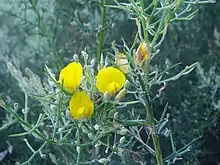Stauracanthus
Stauracanthus is a genus of flowering plants in the family Fabaceae. It includes three species of shrubs and suffrutices native to the Iberian Peninsula (Spain and Portugal) and northwestern Africa (Algeria and Morocco). They grow in Mediterranean-climate maquis (shrubland), woodland, heaths, and coastal scrub, on sandy or stony alluvium and coastal dunes.[1] It belongs to subfamily Faboideae. It is sometimes treated as part of the genera Genista or Ulex.
| Stauracanthus | |
|---|---|
 | |
| Stauracanthus boivinii | |
| Scientific classification | |
| Kingdom: | Plantae |
| Clade: | Tracheophytes |
| Clade: | Angiosperms |
| Clade: | Eudicots |
| Clade: | Rosids |
| Order: | Fabales |
| Family: | Fabaceae |
| Subfamily: | Faboideae |
| Tribe: | Genisteae |
| Genus: | Stauracanthus Link (1807) |
| Species | |
|
3; see text | |
| Synonyms[1] | |
| |
Species
Stauracanthus comprises the following species:[1][2][3]
- Stauracanthus boivinii (Webb) Samp.
- Stauracanthus genistoides (Brot.) Samp.
- subsp. aphyllus (Link)Rothm.
- subsp. genistoides (Brot.)Samp.
- subsp. vicentinus (Cout.)Rothm.
- Stauracanthus spectabilis Webb
References
- Stauracanthus Link. Plants of the World Online. Retrieved 20 September 2023.
- "ILDIS LegumeWeb entry for Stauracanthus". International Legume Database & Information Service. Cardiff School of Computer Science & Informatics. Retrieved 15 April 2014.
- USDA; ARS; National Genetic Resources Program. "GRIN species records of Stauracanthus". Germplasm Resources Information Network—(GRIN) [Online Database]. National Germplasm Resources Laboratory, Beltsville, Maryland. Retrieved 15 April 2014.
This article is issued from Wikipedia. The text is licensed under Creative Commons - Attribution - Sharealike. Additional terms may apply for the media files.